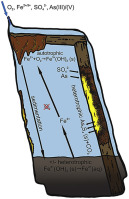当前位置:
X-MOL 学术
›
Appl. Geochem.
›
论文详情
Our official English website, www.x-mol.net, welcomes your
feedback! (Note: you will need to create a separate account there.)
Bioprecipitation of As4S4 polymorphs in an abandoned mine adit
Applied Geochemistry ( IF 3.1 ) Pub Date : 2020-02-01 , DOI: 10.1016/j.apgeochem.2019.104511 Lukáš Falteisek , Petr Drahota , Adam Culka , František Laufek , Jakub Trubač
Applied Geochemistry ( IF 3.1 ) Pub Date : 2020-02-01 , DOI: 10.1016/j.apgeochem.2019.104511 Lukáš Falteisek , Petr Drahota , Adam Culka , František Laufek , Jakub Trubač

|
Abstract Opportunities to study the anthropogenic cementation zones within permanently flooded mine works, where toxic elements accumulate by processes not fully described, are generally very rare. We examined macroscopic arsenic sulfide deposits inside a decomposed timbering of an abandoned mine adit, which had been flooded for 75 years. Bonazziite (β-As4S4) was always the dominant mineral in the deposits (up to 96.5%), while realgar and the ZnS phase were present in minor amounts. These findings differ from near-surface environments, where the most common biogenic As sulfide is realgar and other polymorphs are usually present in trace amounts only. Bonazziite was chemically highly pure with an average As/S molar ratio 0.9. It was 34S depleted compared to both aqueous sulfate and primary sulfides, which is consistent with biogenic sulfur reduction. Sulfide encrustation was confined to individual wood tracheids, indicating the extent of microenvironments that were oversaturated with respect to these minerals. The sulfides were accompanied by older gypsum and younger arsenian schwertmannite indicating complex succession of the redox conditions within the timbering. Authigenic electrum was found in one sample. Analysis of microbial communities revealed the dominance of sulfate reducers and fermenting microorganisms within the timber, similar to realgar-precipitating spots in wetland soils as previously documented. An anoxic environment in the mine water was maintained by autotrophic iron oxidation. The results suggest that a highly reduced microenvironment embedded in anoxic, but relatively oxidized surroundings is the key feature of the realgar and bonazziite-precipitating systems.
中文翻译:

废弃矿井中 As4S4 多晶型物的生物沉淀
摘要 研究永久淹没矿山工程中的人为胶结带的机会通常非常罕见,其中有毒元素通过未完全描述的过程积累。我们检查了一个废弃矿井的分解木结构内的宏观硫化砷沉积物,该矿井已被淹没 75 年。Bonazziite (β-As4S4) 始终是矿床中的主要矿物(高达 96.5%),而雄黄和 ZnS 相仅少量存在。这些发现与近地表环境不同,在近地表环境中,最常见的生物硫化砷是雄黄,而其他多晶型物通常仅以痕量存在。Bonazziite 具有高化学纯度,平均 As/S 摩尔比为 0.9。与硫酸盐水溶液和初级硫化物相比,它消耗了 34S,这与生物硫还原一致。硫化物结壳仅限于单个木材管胞,表明微环境中这些矿物质过饱和的程度。硫化物伴随着较老的石膏和较年轻的砷施维特曼石,表明支护结构内氧化还原条件的复杂连续性。在一个样品中发现了自生金银矿。微生物群落分析揭示了木材中硫酸盐还原剂和发酵微生物的主导地位,类似于先前记录的湿地土壤中雄黄沉淀点。通过自养铁氧化维持矿井水中的缺氧环境。结果表明,嵌入在缺氧中的微环境高度减少,
更新日期:2020-02-01
中文翻译:

废弃矿井中 As4S4 多晶型物的生物沉淀
摘要 研究永久淹没矿山工程中的人为胶结带的机会通常非常罕见,其中有毒元素通过未完全描述的过程积累。我们检查了一个废弃矿井的分解木结构内的宏观硫化砷沉积物,该矿井已被淹没 75 年。Bonazziite (β-As4S4) 始终是矿床中的主要矿物(高达 96.5%),而雄黄和 ZnS 相仅少量存在。这些发现与近地表环境不同,在近地表环境中,最常见的生物硫化砷是雄黄,而其他多晶型物通常仅以痕量存在。Bonazziite 具有高化学纯度,平均 As/S 摩尔比为 0.9。与硫酸盐水溶液和初级硫化物相比,它消耗了 34S,这与生物硫还原一致。硫化物结壳仅限于单个木材管胞,表明微环境中这些矿物质过饱和的程度。硫化物伴随着较老的石膏和较年轻的砷施维特曼石,表明支护结构内氧化还原条件的复杂连续性。在一个样品中发现了自生金银矿。微生物群落分析揭示了木材中硫酸盐还原剂和发酵微生物的主导地位,类似于先前记录的湿地土壤中雄黄沉淀点。通过自养铁氧化维持矿井水中的缺氧环境。结果表明,嵌入在缺氧中的微环境高度减少,










































 京公网安备 11010802027423号
京公网安备 11010802027423号